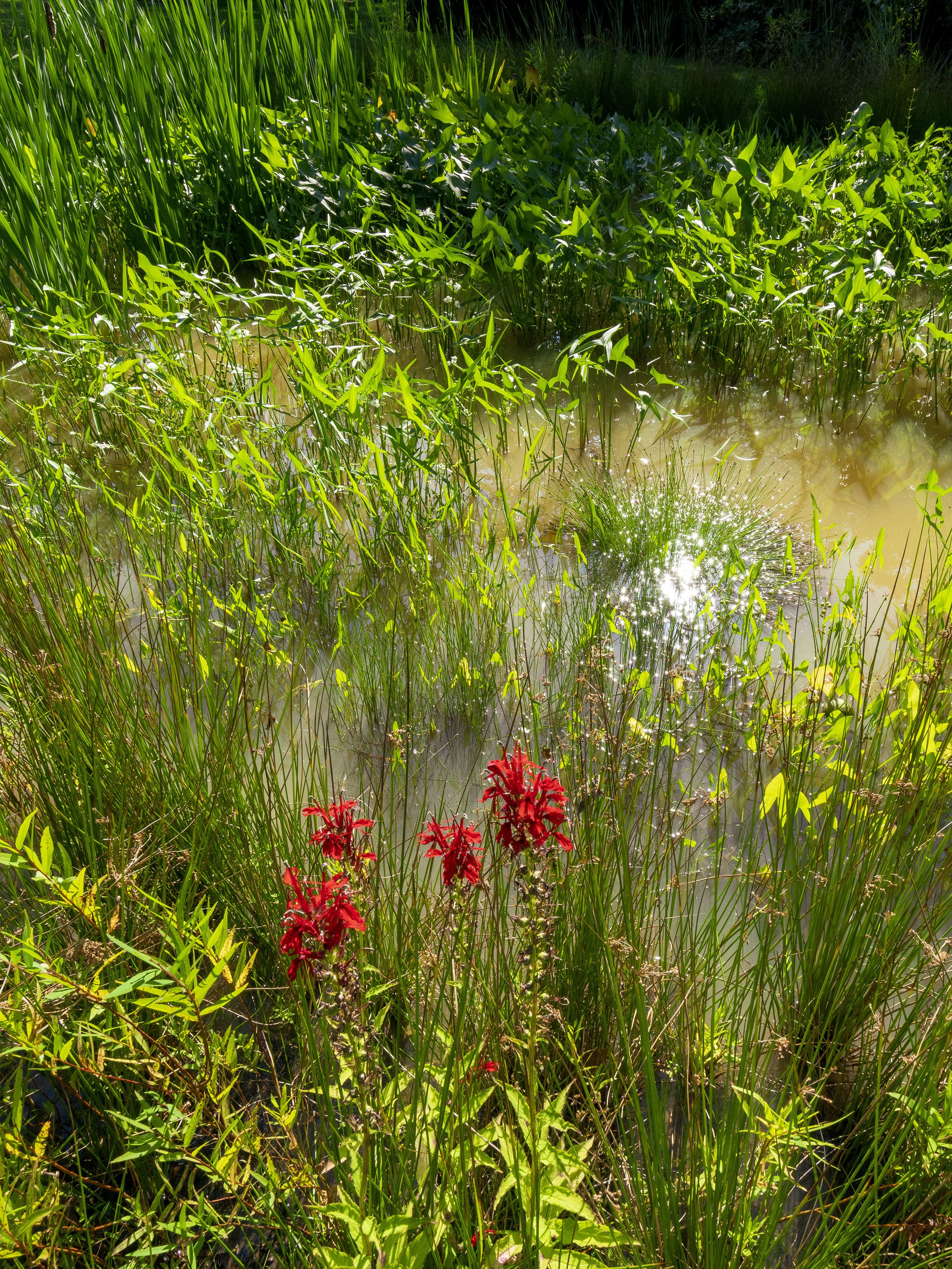In two separate, quiet corners of UNCG’s Peabody Park there lies exquisitely fertile terrain – for wildlife, for native plants, and for research. The work that takes place there spans from water quality to mammal diversity to STEM education to recreational therapy.
Wetlands are among the most productive ecosystems in the world. They provide numerous environmental services, raising runoff water quality and increasing biotic diversity. And when used as living laboratories, wetlands are also extremely productive academic ecosystems.
UNCG’s two wetlands, created in 2017, have quickly become a nexus of research and learning, for the university community and beyond.
Peabody Park dates back to 1901, when the first university president Charles Duncan McIver established it as a place for recreation and hands-on learning for students. Part of the park held a man-made lake, which was drained in 1954.
Sixty years later, Dr. Lynn Sametz – co-director of the UNCG Research and Instruction in STEM Education Network – took a stroll through the park with John Byrd, who had just led a workshop on campus. Sametz and Byrd were discussing creating a wetland as a living laboratory at a nearby high school, and then it occurred to Sametz: why don’t we have them here?
“To love a swamp, however, is to love what is muted and marginal, what exists in the shadows, what shoulders its way out of mud and scurries along the damp edges of what is most commonly praised. And sometimes its invisibility is a blessing. Swamps and bogs are places of transition and wild growth, breeding grounds, experimental labs where organisms and ideas have the luxury of being out of the spotlight, where the imagination can mutate and mate, send tendrils into and out of the water.”
— Barbara Hurd, “Stirring the Mud”
The idea of wetlands on campus caught on quickly. The next year, in 2015, the Wetlands Committee was formed. It included faculty and staff from the College of Arts and Sciences, the School of Education, the School of Health and Human Sciences, and the Joint School of Nanoscience and Nanoengineering, as well as representatives from the Peabody Park Committee, City of Greensboro Water Resources, Greensboro Science Center, and Audubon Society. The committee brought internationally renowned wetlands restoration expert Tom Biebighauser to campus to scout potential locations.
In March of 2016, Sametz, Associate Professor of Biology Malcolm Schug, and now-Professor Emeritus of Biology Parke Rublee submitted a proposal to Provost Dana Dunn, who approved the project. The committee secured a $46,112 grant from Duke Energy Water Resources, as well as support from the UNCG Green Fund.
The following March, Biebighauser led a two-day workshop for more than 100 volunteers made up of facilities staff, faculty, students, and community members. They worked together to construct the two wetlands – one in Peabody Park Woods and one in an open area on the recreation field, the same location Sametz and Byrd had identified when they first conceived the idea.
With opportunities for research and teaching in biology, chemistry, environmental studies, recreational therapy, creative writing, and beyond, the construction of the UNCG Wetlands has revived McIver’s original intention for Peabody Park, and spurred new developments across disciplines.
“Our goal was to put these wetlands on our campus as a resource, for all our faculty doing any kind of research or teaching,” said Schug. “What we see is that there’s a large variety of interested parties.”
The wetlands play an essential part in implementing the National Science Foundation-funded Council for Undergraduate Research Transformations Project, to develop and expand curricula related to undergraduate, high-impact learning. They are a site for multiple high-stakes research projects in biology, chemistry, and education, and their potential for science outreach activities grows daily as more educators from UNCG and across the county learn about them.
To help monitor the health of the new ecosystems and establish and operate outreach programs, the biology department recruited doctoral student Kristina Morales to serve as the UNCG Wetlands graduate assistant. Morales grew up in Florida, near the Everglades. With a close view of how development has affected water quality and environments near her home, Morales feels strongly connected to wetland areas and what can be learned from them.
“I knew I wanted to place myself between human impacts and ecosystem impacts, somewhere between human health and nature’s health.”
On the campus wetlands, Schug, Sametz, Morales, and others help students become contributors to online data collections such as eMammal, known in North Carolina as “Candid Critters.” Through this database, users capture photos of organisms they spot and submit them for identification by expert biologists, so they are stored and available for other researchers and citizen-scientists.
Undergraduates monitor motion-activated cameras to track animal activity. So far, they have logged grey and red foxes, coyote, deer, racoons, rabbits, box turtles, mice, a variety of birds including owls and hawks, and bats.
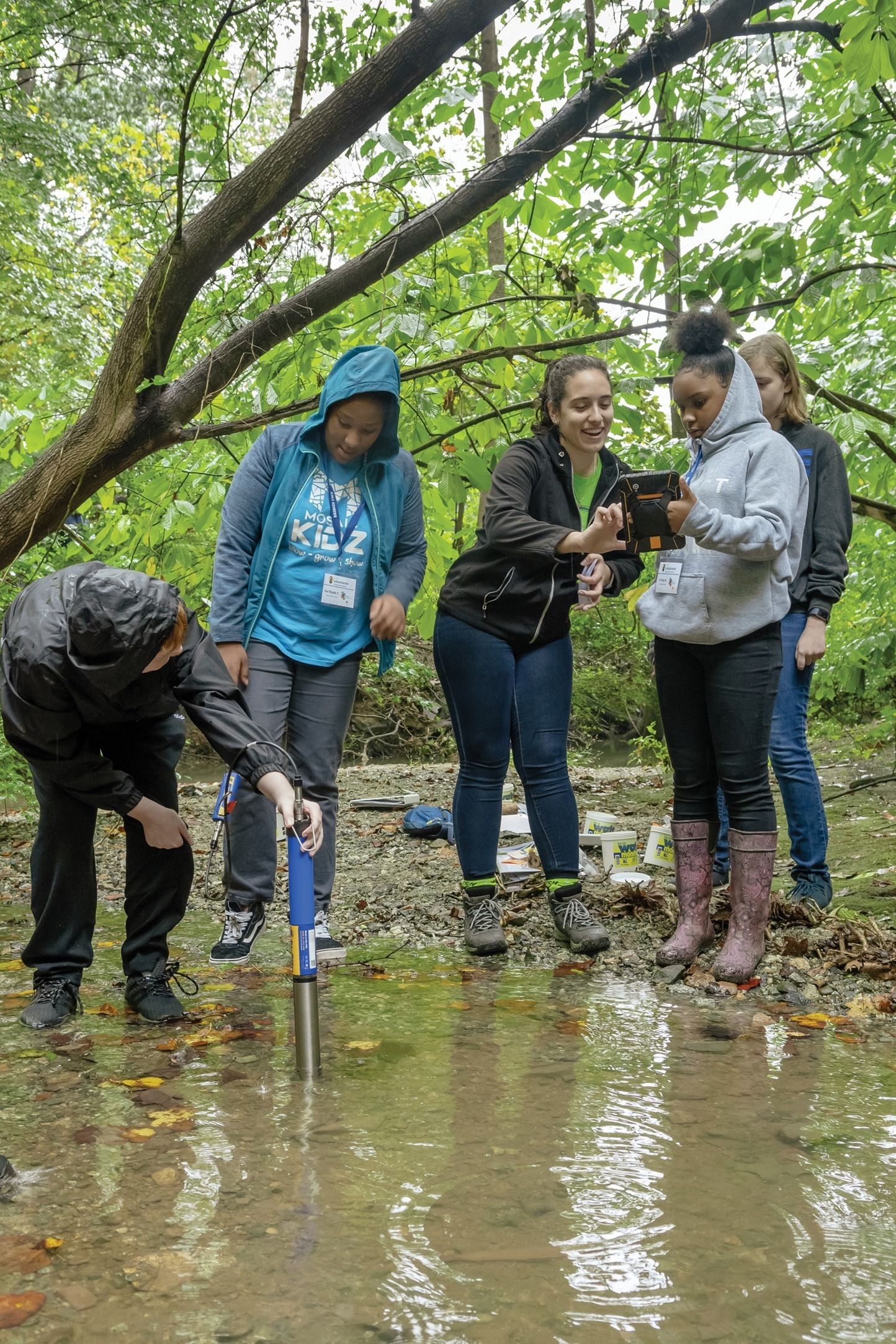
Wetlands graduate assistant Kristina Morales (center) tests water quality with young students as part of a Saturday Academy, a learning experience designed to engage middle school teachers and students in STEM. See more photos on UNCG Research Flickr.

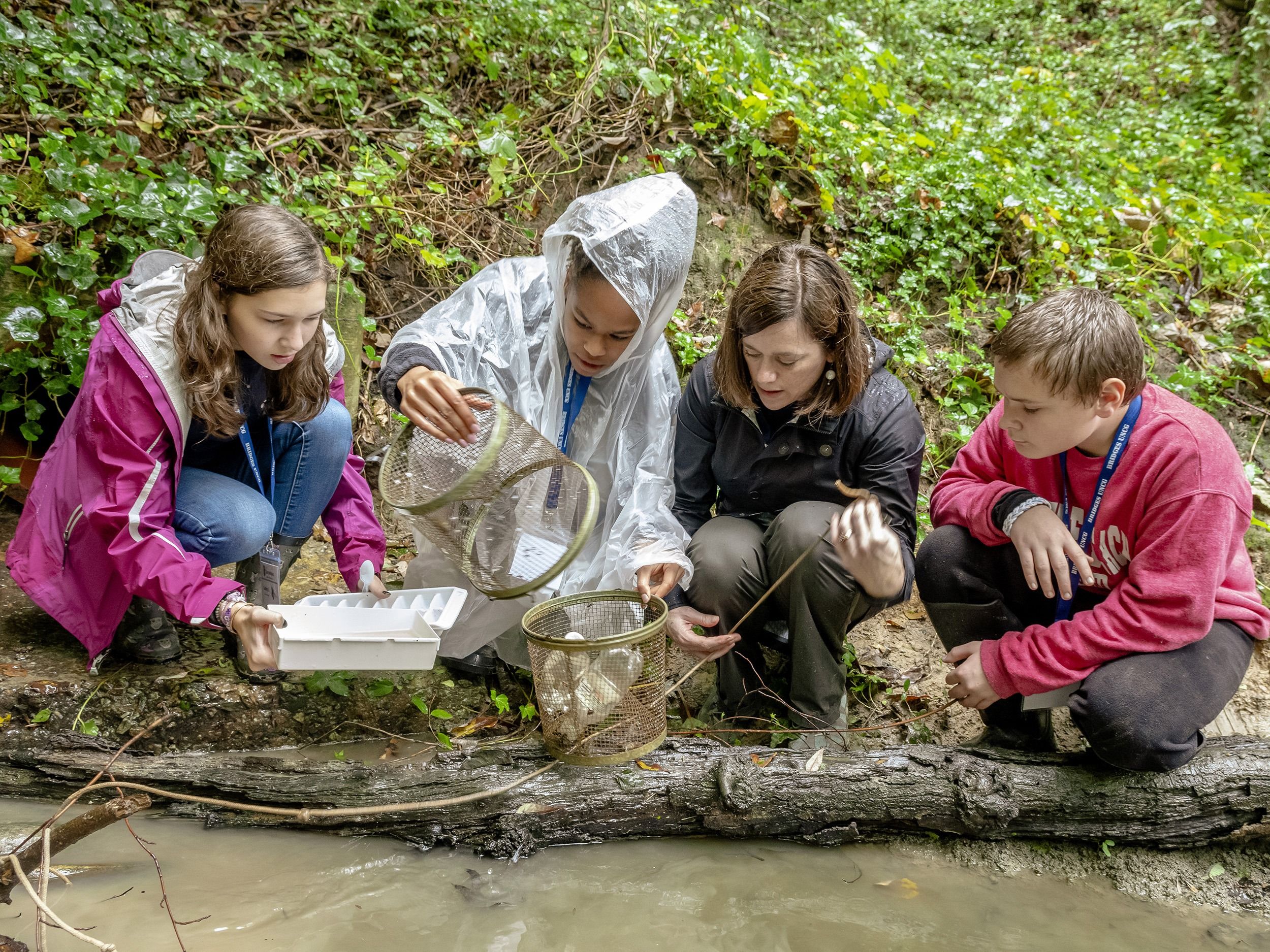
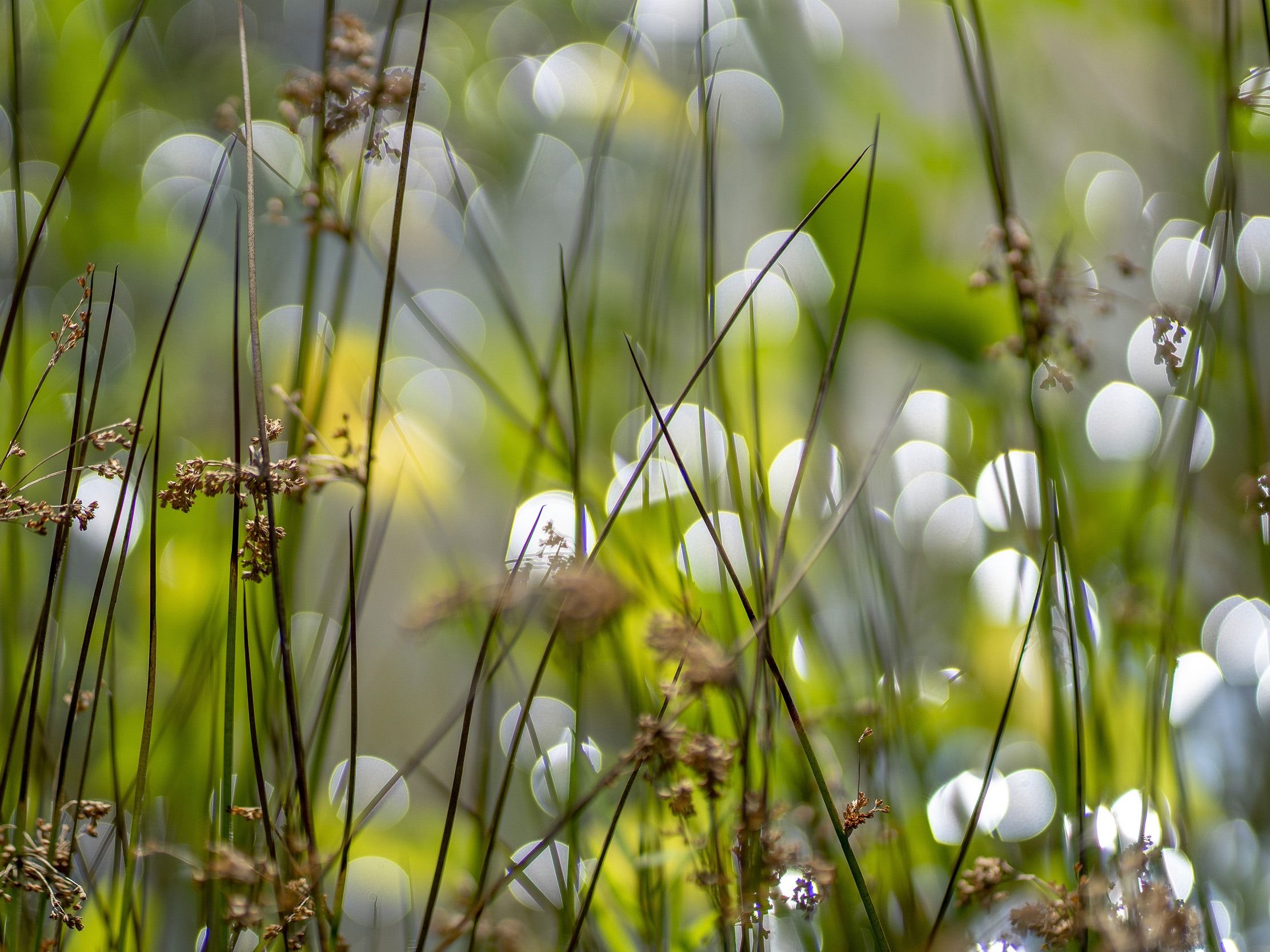
Since the time of European settlement in America, more than 50 percent of the country’s wetlands have been destroyed by commercial and agricultural development, removing crucial ecosystem services and much biotic diversity. Wetlands are also threatened by pollution, climate change and rising seas, and drought. Wetland restoration and construction are growing sustainable practices internationally. See more photos on UNCG Research Flickr.
Outward growth
The university wetlands are an important site for Dr. Heidi Carlone’s “BRIDGES for socio-environmental good,” a project awarded $1.2 million from the National Science Foundation in 2018.
The Hooks Distinguished Professor of STEM Education works with her co-principal investigators – Dr. Sara Heredia and Appalachian State University’s Dr. Lakshmi Iyer – to direct “Saturday Academies” for middle school students and teachers from Guilford, Randolph, and Rockingham Counties.
The researchers engage young students as “stormwater sleuths,” who track where stormwater goes on campus and how it affects water quality, wildlife, and the ecosystem, in addition to how it could be managed through innovative building design.
“These are the experiences that they remember,” says Carlone (photo gallery above, center). “There is a visceral, emotional experience that occurs when we get kids outside and investigating.”
The teaching model engages middle schoolers in environmental problems, and serves as a rigorous study on how to trigger and sustain STEM-related identities among diverse youth – and enhance teachers’ STEM professional learning.
“Every kid has proclivities, interests, and curiosities that can be linked to STEM,” says Carlone.
“We’re not trying to make every kid into a scientist, but we are trying to cultivate a scientifically literate citizenry that appreciates what science and engineering do for our lives – for the betterment of our communities, our personal lives, and our environment.”
Calls of the wild
Acoustic data gathered from the UNCG Wetlands are part of an ambitious effort to amass data related to bats across the continent.
Of the approximately 5,000 species of mammals, nearly a quarter are bats. They trail just behind rodents, to form the second largest group of mammals across the globe. Despite that diversity, and the fact that bats are an essential part of many ecosystems, they are elusive to most people, including wildlife specialists.
“They’re awake when you’re asleep and when you’re awake, they’re gone. Nocturnal animals are really hard to study,” says Professor and Biology Department Head Matina Kalcounis-Rüppell. “Our research is about opening a new window of observation.”
With funding from the U.S. Fish & Wildlife Service, and in partnership with the North Carolina Resources Commission, Clemson University, and the South Carolina Division of Natural Resources, UNCG biology researchers from Kalcounis-Rüppell’s Bat and Mouse Lab are monitoring 161 bat research sites across North Carolina, a number that has more than doubled over the past two years.
Their work on the Carolinas Regional Acoustic Bat Survey has also served as a pilot for the North American Bat Monitoring Program, or NABat, a survey effort that spans the continent to promote bat conservation.
The North Carolina sites range from sea level at Fort Fisher to the Blue Ridge Parkway at 6,000 feet, to downtown Charlotte, and everywhere in between. As home to both northern and southern distributions of bat populations and a wildly varying range of ecosystems, the Carolinas are extremely fertile for biological research. North Carolina boasts 17 different species of bats, the largest number on the East Coast.
Data collected by UNCG are useful to groups interested in bat distribution, from the U.S. Forest Service to the State of North Carolina and the Eastern Band of Cherokees. The information can affect land use decisions and priority management of wildlife.
“The work is really interesting because of the scale,” says Kalcounis-Rüppell. “We can say what’s important to bats at a larger scale – say, across the state – instead of at just one or a few sites.”
The data are also used by scientists at UNCG to answer important ecological questions, from studies on bat social behavior to questions about how water quality affects animal populations.
Postdoctoral researcher Han Li compares bat populations to assess the impact of human activities. He also trains state biologists working with bats. In 2017, Li received the Golden Bat Award from the North Carolina Bat Working Group, in recognition of his contributions to bat conservation.
“We really can’t take the risk of losing them,” he states in the UNC-TV documentary “Saving Bats,” which also aired on PBS. “Just based on pest control, bats can save billions a year for the farming industry of the United States.”
Researchers know bats are essential to human health.
“The job that bats are doing is really critical for ecosystem functioning around the world,” says Kalcounis-Rüppell. “Without bats, we’d be overrun by insects. If bats were taken out of the environment, it would be devastating – for agriculture, for disease control, for plants. They’re providing a major service.”
They’re also an excellent bioindicator species.
“If bats are doing well, that’s a good indicator of the health of the environment,” she says.
On campus, the researchers are tracking bats to measure the restored wetlands’ impact on biodiversity. Over the last year, they have analyzed nearly half a million bat calls from the UNCG Wetlands.
“Studies on bats are a powerful way to ask questions about these broader issues,” says Kalcounis-Rüppell. “It’s not just about bats.”
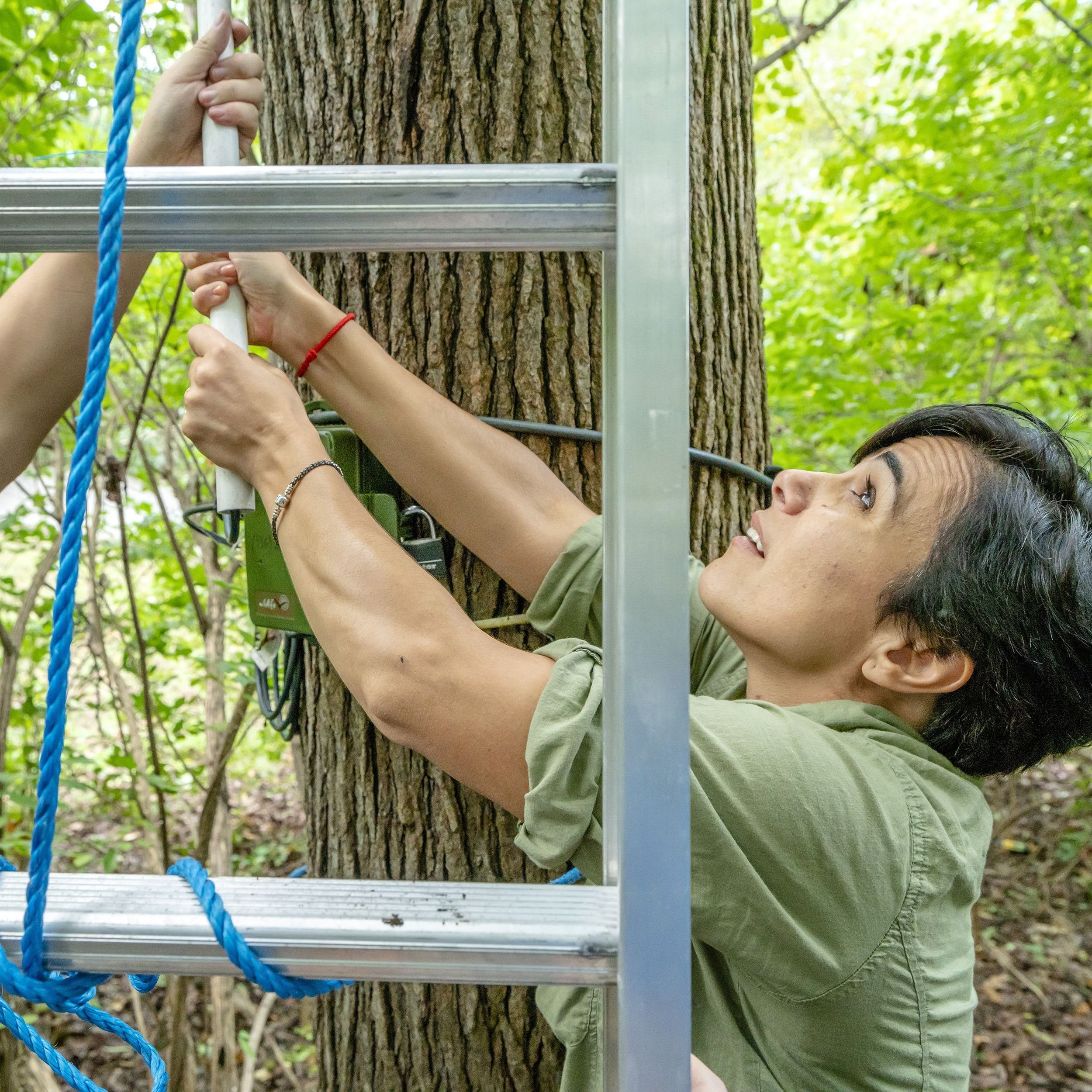
Bats use ultra-high frequency sound waves to find prey and avoid obstacles in the dark. Kalcounis-Rüppell, Li, and their collaborators set up recording equipment at research sites, capturing every ultrasound produced from dusk to dawn. Back at the lab, they comb through hours of bioacoustic data to identify bats in the area.
Kalcounis-Rüppell has developed a similar system to study wild mice. “We know mice use ultrasound to communicate, but researchers don’t really know what they’re saying to each other,” she says. As one of the only scientists studying mouse ultrasound in the wild, she’s at the leading edge of her field. “We’re seeing what these animals are doing in the dark.” See more photos on UNCG Research Flickr.
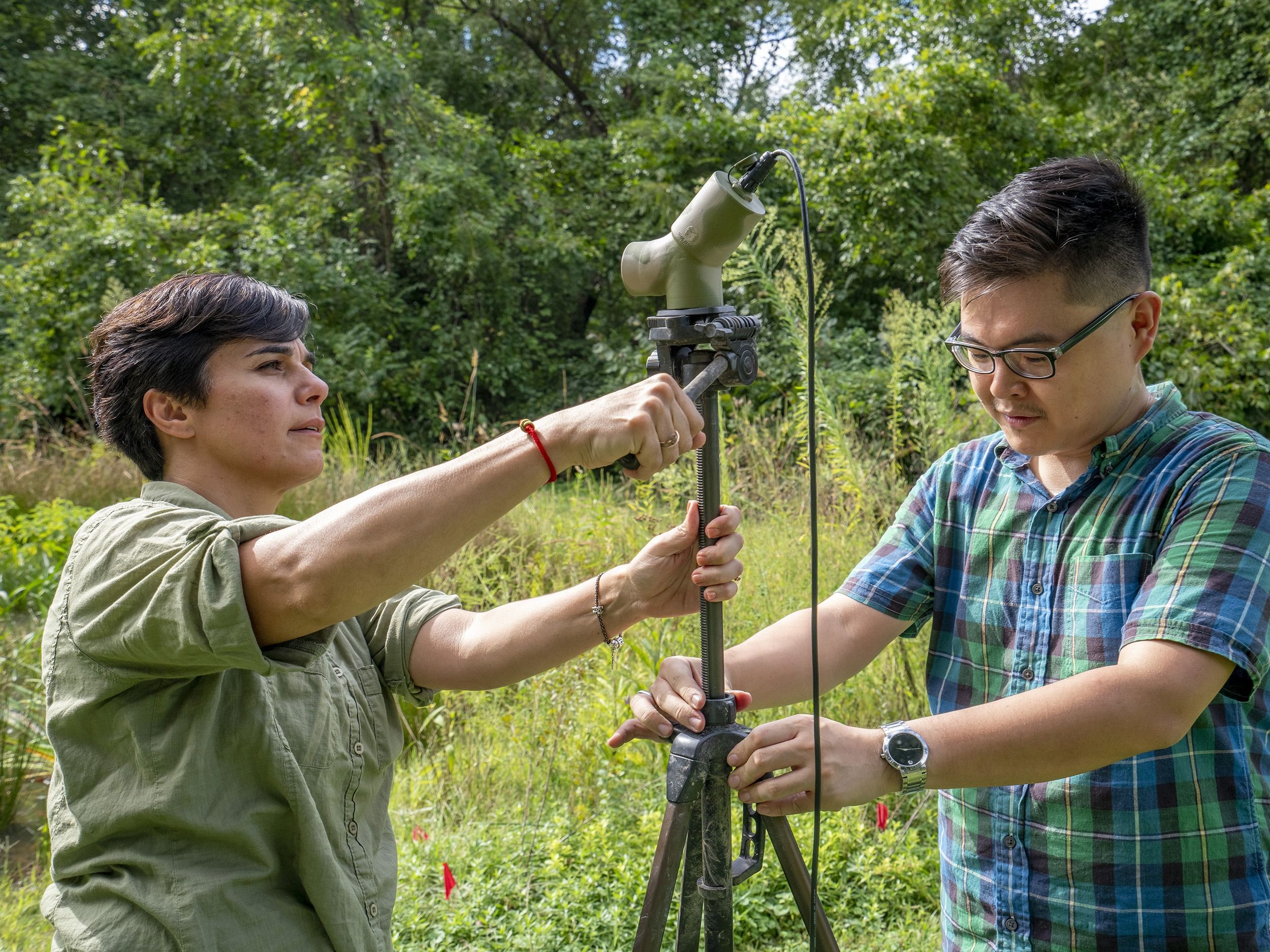
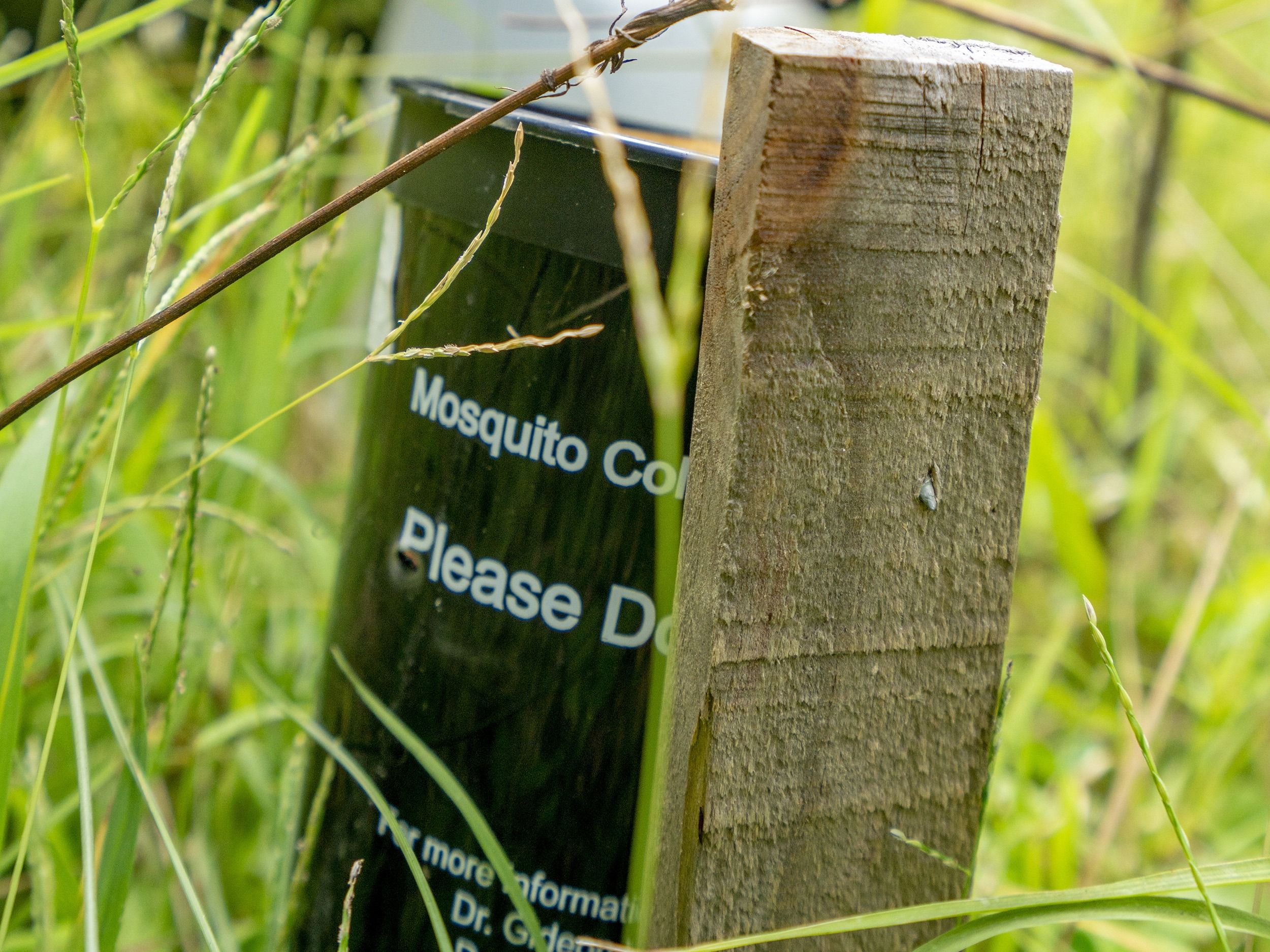

“We’ve made interesting discoveries about what bats do in different parts of the state,” says Kalcounis-Rüppell (first photo). “Some bat species that normally hibernate aren’t doing so on the warmer, coastal plains.” That could have important implications for species threatened by white nose syndrome, a disease killing millions of North American bats. It only attacks during hibernation. See more photos on UNCG Research Flickr.
Mercury Rising
Wetlands benefit water quality and biodiversity in many significant ways, but there is a flip side, and UNCG scientists are examining that too.
Unexpectedly, the biggest drawback isn’t mosquitoes, but methylmercury – a toxic, organic form of mercury produced by microbes in aquatic systems. Advisories about consuming fish and seafood refer to this type of mercury, a neurotoxin that has a longer residual life in the body than inorganic forms.
Assistant Professor of Biology Martin Tsz-Ki Tsui has studied mercury since 2002. The element netted his interest because of its complicated chemistry and the fact that it is the only heavy metal that can travel around the world in the form of gas.
“Even after four to five decades of research on mercury, there are still new things coming out,” he says. “Isotope analyses – which allow us to understand the sources of mercury we find – have only been used during the last 10 years.”
Tsui’s latest work focuses on mercury cycling in wetlands and identifying sources of methylmercury found in songbirds who inhabit wetlands.
“Recently it was recognized that mercury can interrupt the endocrine system in birds and mammals,” he explains. “Songbirds are quite sensitive.” Like bats, they are a valuable indicator species.
Are they biting?
Another concern about constructing wetlands in populated areas? The potential for more mosquitos and associated public health risks.
Associate Professor of Biology Gideon Wasserberg engaged students in his Landscape Ecology and Ecoepidemiology of Infectious Diseases courses in evaluating if the campus wetlands increase mosquito populations.
At wetlands and control sites, students positioned cups of water containing germination paper, which they collected weekly and studied in the lab, assessing numbers of eggs laid and rearing larvae to adulthood for species identification. Students also sampled the ponds, to assess them as potential breeding sites.
“Mosquito abundance is indeed higher,” says Wasserberg (third photo above, right). The predominant species was the Asian tiger mosquito. “But surprisingly, larval yield from the actual ponds was negligible, probably due to the presence of natural enemies such as fish and dragonfly nymphs.”
The ponds don’t seem to be significant breeding grounds, he explains. But increased humidity and decomposing leaf litter around the ponds may be attracting mosquitos from nearby areas.
Graduate students in Tsui’s lab are carrying out their own projects on methylmercury in wetlands.
Kristina Morales collects monthly water samples and sediment
from the campus wetlands and surrounding sites at Buffalo Creek, Guilford Technical Community College, and the Greensboro Science Center. She and Tsui are studying the connectivity of wetland sites and nearby waterways, and the potential for breakdown of methylmercury by sunlight.
Their latest results show the forested campus wetland area has slightly higher concentrations of methylmercury than the open field site. Findings like these could contribute to future restoration techniques that decrease human mercury exposure.
Next, Morales hopes to compare mercury cycling in the recently restored wetlands to older, established wetlands. She suspects the newer sites are producing more methylmercury.
“You can’t simply replace ecosystem services,” she says. “They are of a certain age, and with the nutrient cycling and the way it’s functioning, it’s not something you can cut and paste.”
Further east, Ph.D. student Yener Ulus is examining whether saltwater intrusion caused by rising sea levels is raising the amount of methylmercury produced in coastal wetlands.
In the lab, Tsui and his students have found that adding seawater to freshwater wetland soils produces large amounts of methylmercury. That could have grave implications for coastal wetlands, Tsui says, as sea levels rise due to climate change.
Ulus, who comes from a coastal region of Turkey, is collecting samples from three types of landscapes in North and South Carolina: coastal wetlands, degraded coastal wetlands, and salt marshes. Results of his early analyses, he says, support their laboratory findings.
Ulus hopes to one day conduct similar research in his home country, with an eye on how coastal construction could affect health, fishing, and the economy. “My hometown is right on the ocean, and it relies on fishing and farming. Construction is going on right next to the ocean, and I believe this will be a big problem in my town and country in the future.”
While specifics of projects differ, the many students and faculty working at the UNCG wetlands all have similar goals. “It’s about filling in knowledge gaps,” says Tsui, “and promoting practices that improve human and ecosystem health.”
